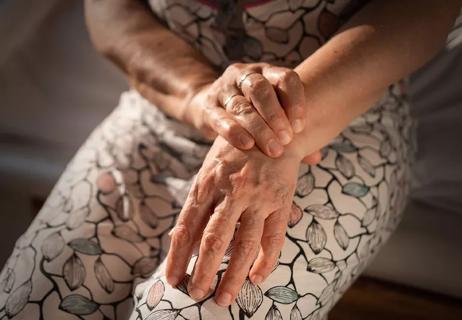Both types of therapy work differently, but they can both alleviate symptoms — especially when you alternate methods

Your arthritis is causing joint pain, stiffness and inflammation. And you’re about to reach for a heating pad or an ice pack to get some relief. But is heat or ice better for arthritis?
Advertisement
Cleveland Clinic is a non-profit academic medical center. Advertising on our site helps support our mission. We do not endorse non-Cleveland Clinic products or services. Policy
Both are good options, with heat therapy soothing stiff joints and cold therapy reducing pain. In fact, some people find the best relief when alternating between both.
Rheumatologist Rochelle Rosian, MD, explains when to use heat or ice for arthritis and provides some guidance on how to alternate between hot and cold therapies.
Heat and ice are both simple, inexpensive methods for relieving arthritis pain. Common types of arthritis include osteoarthritis, rheumatoid arthritis, gout and psoriatic arthritis.
“Cold reduces swelling and numbs the area, while heat loosens up muscles, increases flexibility and increases circulation,” outlines Dr. Rosian.
Cold therapy works by contracting your blood vessels, which reduces blood flow to your joints and muscles. Heat therapy, on the other hand, dilates your blood vessels, which improves your circulation.
Is heat good for arthritis pain?
Yes — and to safely apply heat, Dr. Rosian suggests soaking in a warm bath, hot tub or whirlpool for about 20 minutes. You can also take a warm shower. Dress warmly afterward to prolong the benefit. A heating pad is another good way to warm up an area.
“You can also buy moist heat pads or heat a damp washcloth in the microwave for about 20 seconds,” she recommends. “Test it to make sure it’s not too hot. Wrap it in a dry towel and apply it to the painful area.”
Advertisement
The benefits of using heat therapy include:
Heat therapy can be a good tool to help with your arthritis pain, but you need to be careful about what temperature you’re using — if it’s too hot, you can burn your skin.
There’s no universal temperature when it comes to heat therapy, so you’ll want to find one that’s comfortable for you. A good recommendation is to keep your shower temperature between 92 and 100 degrees Fahrenheit (33.3 and 37.7 degrees Celsius).
“If there is injury or inflammation, using heat and the resulting increase in blood flow could lead to an increase in swelling,” warns Dr. Rosian.
The easiest way to apply cold therapy is to use an ice pack. Apply for 20 minutes at a time. Gel-filled cold packs are inexpensive and available in different sizes and shapes.
“You’ll want to keep several in the freezer,” says Dr. Rosian. “Frozen peas or ice cubes in a baggie also work.”
The benefits of using cold therapy include:
Cold therapy can help manage your pain. You should wrap any cold or frozen items in a towel before using them on your skin. If you don’t, you risk frostbite or damage to your skin.
When it comes to heat or cold for arthritis, try them both and use whichever works best for you. You may opt for heat therapy in the morning and then turn to cold therapy later in the day.
For an acute injury, such as a pulled muscle or injured tendon, the usual recommendation is to start by applying ice to reduce inflammation and dull pain. Once inflammation has gone down, heat can be used to ease stiffness.
For a chronic pain condition, such as osteoarthritis, heat seems to work best. But Dr. Rosian shares that some people find that cold also helps to dull the pain.
“Remember that exercise is an important part of treatment for all arthritis. Heat and cold can also be used to make exercising a little easier,” she adds. “Try using heat before exercise to loosen up muscles and cold afterward to minimize any achiness.”
When it comes to heat or cold therapy, the choice is yours. Depending on the symptoms you’re experiencing, one may work better than the other — or you may find that a combination of using both heat and cold therapies helps alleviate your symptoms.
And if you’re still unsure which one is best for you, Dr. Rosian says you can always talk to your healthcare provider for recommendations on how to manage your pain and discomfort.
Advertisement
“Heat and cold are great options to manage pain and stiffness every day or with flare-ups,” she reiterates. “So, remember, ‘heat to warm up’ and ‘ice to cool down’ to keep joints moving throughout the day.”
Advertisement
Learn more about our editorial process.
Advertisement

Research doesn’t show any benefits to wearing copper bracelets — but your experience may vary

Yes, your genetic makeup may increase your risk of developing arthritis, but other factors like age and weight can play a role, too

The process usually starts with your primary care provider, who may refer you to a rheumatologist or orthopaedist

Exercising can actually improve arthritis symptoms — and low-impact exercises are best

Simple exercises like tendon glides and finger lifts can have a big impact

Research is inconclusive, so don’t stop eating tomatoes, potatoes and peppers just yet

Adding these simple foods to your diet can make a big difference

Here's how to make yourself more comfortable behind the wheel

Babies can get congested easily, but you can calm their cough by keeping them hydrated, using nasal drops and running a humidifier

Weight loss may cause loose, sagging skin and muscle loss to your rear

Several conditions, like vitiligo and fungal infection, can cause a loss of pigmentation, leading to white spots or patches on your skin